Abstract
This study characterises the natural stone used in the Great Mosque of Córdoba (Spain) and establishes correlations to enable non-destructive, in situ assessment of the mechanical strength of the material. Quarry ashlars of the same biocalcarenite were tested to determine bulk density, ultrasonic wave propagation velocity (UWPV), and mechanical properties from uniaxial compression, splitting tension, and three-point bending tests (over 100 specimens). The stone showed no significant anisotropy or specimen size effects within the investigated ranges. Reference mechanical values were obtained, with a mean uniaxial compressive strength of about 6 MPa. A strong linear correlation was found between UWPV and compressive strength (R2 ≈ 0.86), supporting the use of ultrasonic testing to estimate compressive strength on site. In addition, flexural strength can be also estimated since it correlated strongly with compressive strength (R2 ≈ 0.95); in contrast, the correlation with tensile strength was moderate (R2 ≈ 0.31). The results provide validated relationships for Córdoba freestone that improve the reliability of ultrasonic tests for providing valuable information for structural analysis, maintenance, and conservation strategies for heritage buildings constructed with this kind of stone. The proposed approach offers a practical pathway for damage-free evaluation of mechanical performance in historical masonry.
1. Introduction
The Great Mosque of Córdoba is one of the most significant monuments in the Islamic West and a masterpiece of world architecture. It exemplifies the peak of the Hispano-Muslim style, featuring innovative construction techniques and intricate decorative elements. Built between 780 and 990, it underwent several expansions under different emirs and caliphs, each contributing to its unique architectural identity. Following the Christian reconquest, a cathedral was inserted within the structure in the 12th century, making it the only religious site in the world where a mosque and a cathedral coexist. Recognised for its historical and cultural importance, UNESCO designated it a World Heritage Site in 1984 [,]. Today, with over one million annual visitors, it remains one of the most valuable heritage landmarks in the region.
A distinctive feature of the Mosque is its construction through the reuse of spolia, incorporating elements from earlier prominent buildings []. These include Roman marble columns and Byzantine capitals, seamlessly integrated into its structure. However, the majority of the monument was built using freestone from the Córdoba region, extracted from nearby quarries. This stone, a biocalcarenite, has historically been one of the most widely used lithic materials in Córdoba. Various types of biocalcarenites—biomicrite, biosparite, and biorudite—can be identified in many of the city’s historical monuments []. These stones originate from Tortonian marine marginal facies within the Guadalquivir Depression, forming amalgamated carbonate deposits with a sandy matrix, rich in fossils and sedimentary microfauna. Their physical and mechanical properties make them well-suited for architectural applications but also subject them to weathering and degradation over time [,].
Ensuring the long-term conservation of this architectural treasure requires a thorough understanding of its mechanical behaviour and structural stability. A key aspect of this effort is the study of the mechanical properties of its construction materials, mainly the original stone, making its characterisation essential for conservation efforts []. The mechanical properties are necessary, for instance, for the development of numerical models for the assessment of the structural behaviour, seismic performance and risk assessment, structural reinforcement designs, etc. [,].
These properties can be determined through mechanical testing of material samples in a laboratory setting. Among the most relevant tests is the uniaxial compressive test, which provides a direct evaluation of the material’s compressive strength and is a fundamental part of the characterisation of building stones from archaeological sites [].
However, extracting specimens directly from the monument is impractical due to its protected status. As an alternative, in situ testing offers a non-destructive approach to material characterisation []. Ultrasonic and sonic methods, ground-penetrating radar for investigating subsurface features, infrared thermography for identifying thermal anomalies and material variations, and photogrammetry and laser scanning for detailed geometric documentation, are employed in the assessment of heritage structures [,]. Integrating data from multiple non-destructive techniques offers a more comprehensive understanding of the condition and material characteristics of historical buildings [].
Among these, ultrasonic wave propagation velocity (UWPV) testing is a widely utilised technique to measure wave propagation and infer material properties, such as compressive strength, stiffness, and stone deterioration [,,,]. Furthermore, UWPV testing offers the advantage of assessing the structural integrity and detecting internal defects within heritage stones [].
Despite its potential, the existing literature lacks sufficiently strong correlations to reliably interpret ultrasonic results for this specific stone [,,,,,]. To enhance the reliability of this method, the determination of robust correlations between the results of ultrasonic tests and the mechanical properties of the natural stone is essential.
Sonic tests, which use lower-frequency waves, are often considered more suitable for heterogeneous materials such as granite masonry due to reduced attenuation []. In particular, the Direct and Indirect Sonic Impact Methods have shown the potential to determine both P and R wave velocities in masonry walls, allowing the estimation of their Young’s modulus [,,].
However, the need for further research to develop robust, material-specific correlations for ultrasonic testing and other methods remains critical for enhancing the reliability of mechanical characterisation of stones in heritage construction []. Future efforts should also focus on standardizing UWPV protocols and exploring the integration of UWPV result data with advanced modeling tools like Heritage Building Information Modeling to improve diagnostic capabilities [].
Consequently, the primary objective of this study is to establish correlations that enable the in situ assessment of heritage buildings constructed from the freestone from Córdoba (or similar natural stone), allowing for the determination of their mechanical properties on site without causing damage. This will be achieved through UWPV testing, which, if successfully correlated with mechanical properties obtained from mechanical tests, could serve as a reliable tool for structural evaluation and conservation efforts. This study thus aims to validate ultrasonic testing as a viable technique for assessing the mechanical properties of this stone in heritage buildings, ensuring accurate and damage-free structural evaluation.
This study is based on the laboratory testing of six ashlars composed of the same biocalcarenite found in the monument. First, the anisotropic behaviour of the stone is evaluated by analysing its mechanical response in two principal orientations, A (vertical in the quarry) and B (perpendicular), to determine whether directional dependence affects its mechanical properties. Next, the potential influence of sample size is examined by testing specimens of two different dimensions (50 × 50 × 50 cm3 and 70 × 70 × 70 cm3) to assess scale effects. To obtain reference values, mechanical tests are conducted on the ashlars, measuring key mechanical properties: compressive, tensile, and flexural strength. These values serve as a benchmark for comparison with ultrasonic testing results. The core of this study involves correlating ultrasonic velocity with compressive strength, verifying whether the ultrasonic method can reliably estimate mechanical properties. Finally, further correlations are established between compressive strength and other key properties (tensile and flexural strength), allowing for their indirect determination through in situ testing.
Once the correlations are established, it would be possible to obtain the propagation velocity in situ by means of UWPV, then calculate the stone compressive strength through the correlation with the compression tests, and finally correlate that value with the flexural and tensile strength of the material. This approach aims to improve the accuracy and applicability of ultrasonic testing for assessing the structural integrity of the Great Mosque of Córdoba and other historic buildings constructed with similar materials.
2. Materials and Methods
The Mosque was built using spolia from other prominent buildings, comprising Roman marble columns and Byzantine capitals. However, the largest part of the structure was constructed with local freestone extracted from Miocene biocalcarenites belonging to the Tortonian marine facies of the Guadalquivir Basin. These stones—biomicrites, biosparites and bioarenites—consist of carbonate grains and fossil fragments within a calcitic sandy matrix. Their mineralogical and textural characteristics have been documented in detail by [], who reported quartz, calcite, ankerite, feldspar, micas, and accessory minerals with variable porosity and fossil content in the Mosque’s masonry. The same lithotypes are described in later regional studies of Córdoba’s monuments [,], confirming the shared geological origin of these stones within the Guadalquivir Depression.
Given the impossibility of removing samples from Córdoba’s Mosque itself, the six ashlars of 40 × 30 × 10 cm3 (Figure 1) used in this research were obtained from the quarry Mármoles y Piedras Gutiérrez [], located within the same Tortonian biocalcarenite formation and currently authorised for restoration works in the Mosque. The ashlars’ mineralogical composition (calcitic matrix with quartz and phyllosilicate inclusions) observed in SEM/EDS analyses (as will be described in Section 2.1) is consistent with the descriptions provided by the cited studies, confirming the compatibility and representativeness of the sampled stone with respect to the Mosque’s original material.
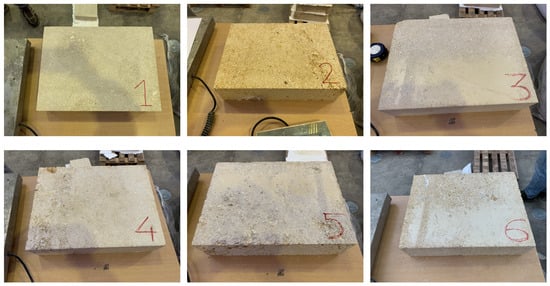
Figure 1.
Ashlars received from the quarry.
2.1. Stone Composition: Microscopy and Spectroscopy
Three stone samples underwent a microscopy analysis using a High-Resolution Field Emission Scanning Electron Microscope (FEI Teneo) to examine their microstructure and morphology. This technique enabled the visualisation of the stone’s surface and internal structure, revealing the size, shape, and distribution of its components. Additionally, Energy-Dispersive X-ray Spectroscopy (EDS) was employed alongside the microscope to determine the elemental composition of specific areas within the samples. For each sample, six measurements were conducted to ensure accuracy and reproducibility.
The microscopy analysis revealed that the stone features a calcite (calcium carbonate) matrix, visible as smaller grains in Figure 2. This matrix acts as a binding agent, providing structural cohesion by holding the rock’s components together. This conclusion is supported by prominent calcium (Ca) and oxygen (O) peaks observed in the EDS spectrum (Figure 3, left). In addition, the material contains a significant amount of quartz, identified as larger and darker grains in Figure 2. This finding aligns with the peaks for silicon (Si) and oxygen (O) in the EDS analysis (Figure 3).

Figure 2.
High-Resolution Scanning Electron Microscope FEI Teneo image of one of the samples, where Cal = calcite, Qz = quartz, and Ph = phyllosilicates.

Figure 3.
EDS for the calcite matrix (a) and quartz and phyllosilicates (b).
In addition, angular inclusions of phyllosilicates were observed, characterised by their bright, angular shapes in Figure 2. These inclusions correspond to the detection of iron (Fe), aluminium (Al), and magnesium (Mg) in the EDS spectrum (Figure 3). These results are consistent with previous studies on heritage buildings in the region, which also employed Córdoba’s freestone as a construction material [,].
2.2. Bulk Density
The bulk density was determined by immersion for six specimens from ashlars 1, 2, and 3 following the UNE-EN 1936:2007 standard []. The process involved weighing oven-dried specimens to obtain their dry mass (), followed by vacuum treatment at 2.0 ± 0.7 kPa for 2.0 ± 0.2 h to remove air from open pores. Deionised water at 20 ± 0.5 °C was then introduced under maintained vacuum, fully submerging the specimens within 15 min. After vacuum release, specimens remained submerged for 24 ± 2 h at atmospheric pressure. Measurements included the mass in water () and the saturated surface-dry mass (), used to calculate bulk density. The study extended saturation to 168 h to verify complete saturation, as the standard lacks clarity on whether immersion at 24 h is sufficient.
For comparison, the same samples were also analysed using a geometric method: edge measurements provided an approximate volume, with density calculated as mass divided by this volume. Results showed only a 2% discrepancy between immersion and geometric methods (Table 1), validating the latter for testing all the samples employed in the study. The resulting mean values per ashlar can be seen in the following table (Table 2).

Table 1.
Comparison of density determined by immersion and geometric methods for selected samples.

Table 2.
Mean density per ashlar.
The final average density across all Córdoba’s freestone specimens was 1820 kg/m3, aligning closely with literature values for similar biocalcarenites [], with densities ranging from 1200 kg/m3 (highly porous) to 2400 kg/m3 (low porosity) depending on diagenesis and fossil fragment density.
2.3. Experimental Tests
In order to achieve the discussed objectives, the ashlars were first cut in smaller samples (Table 3) and then analysed through ultrasonic wave propagation velocity (UWPV) testing. With this method (see Section 2.3.1), the UWPV through several samples for each ashlar were measured. Then, the samples were subjected to mechanical testing, allowing for an accurate determination of the ashlar’s mechanical properties: compressive, bending, and tensile strength (see Section 2.3.2). Finally, the results of both campaigns were used to establish correlations between the propagation velocity and the mechanical properties.

Table 3.
Number of samples tested for each test type.
The UWPV and mechanical tests are described in the following sections.
2.3.1. UWPV Tests
The UWPV of volumetric P-waves was determined by generating an excitation pulse on one side of the specimen and measuring the time of flight to a sensor positioned on the opposite side. This direct transmission method was conducted in accordance with technical recommendations [], with ten measurements taken at each location. The UWPV was computed as the ratio of the travel distance to the measured time of flight. The equipment records the received signal following the excitation pulse (Figure 4).
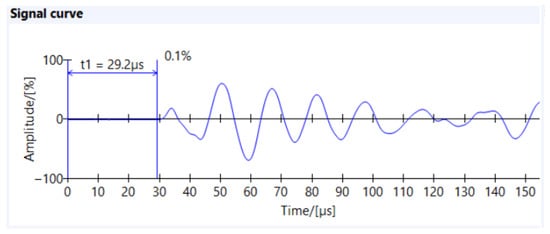
Figure 4.
Receiver signal from ultrasonic equipment.
A Proceq Pundit Lab system was utilised, employing two 54 kHz piezoelectric transducers, which could function interchangeably as transmitters or receivers (Figure 5). These transducers were selected to accommodate varying inspection distances. The UWPV test was performed on all specimens in multiple orientations, as detailed in Section 3.1.
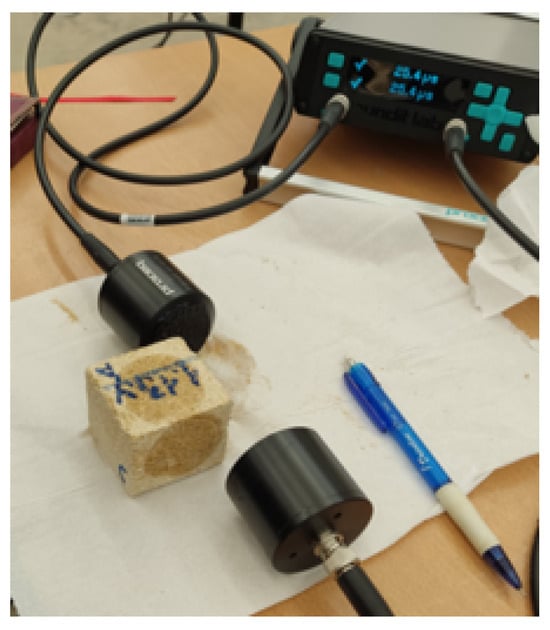
Figure 5.
UWPV testing equipment.
2.3.2. Mechanical Tests
As previously indicated, three types of mechanical tests were performed:
- Uniaxial compression;
- Three-point bending;
- Splitting test.
As these are destructive tests, each specimen was loaded up to failure only once; however, multiple specimens were tested for each property, as detailed in Table 3.
The tests were performed using a universal servo-hydraulic testing machine (200 kN capacity and 200 mm displacement stroke). The compression and three-point bending tests were performed following the specific standards for natural stone [,]. For the splitting test, the procedure was based on the rock mechanics standard [], supplemented by the concrete code [] for specific details regarding the prismatic specimens. The compression and three-point bending tests were displacement-controlled at a 1 mm/min speed rate, while the splitting tests were force-controlled at a 125 N/s loading rate. A scheme and a picture of the experimental setup of each test are shown in Figure 6 and Figure 7.

Figure 6.
Test setup for the uniaxial compression test (a), three-point bending test (b), and split test (c). The arrow shows the loading direction.
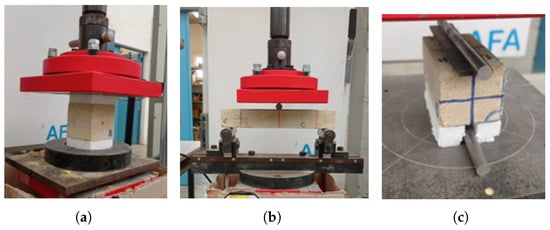
Figure 7.
Images of the test setup for the uniaxial compression test (a), three-point bending test (b), and split test (c).
During the uniaxial compressive strength testing setup, it was decided to employ expanded polystyrene sheets to minimise the effect of geometric irregularities and to ensure a proper distribution of the load among the surfaces. For the same purpose, neoprene strips were used in the splitting tests between the loading rolls and the specimen surface.
The measurements taken during the tests are processed to obtain the desired properties values as follows (Equations (1)–(3)).
Uniaxial compression test:
Three-point bending test:
Splitting test:
where (see Figure 6)
- F is the peak load;
- A is the area of the cross-section of the sample;
- l is the length among loading points;
- L is the length of the contact line;
- b is the sample width;
- h is the sample thickness.
Before performing any further analysis, the resulting dataset was filtered to remove potential outliers that could skew the results. This was achieved by applying a statistical outlier removal process based on the commonly used empirical rule of normal data distribution. Specifically, any data points falling outside the range defined by (two standard deviations below the mean) and (two standard deviations above the mean) were excluded from the analysis.
3. Results and Discussion
3.1. Stone Anisotropy
In order to assess the possible anisotropic behaviour of the material, both uniaxial compression tests and ultrasonic tests were conducted on cubic samples (see Table 4). The ultrasonic test, being non-destructive, can be repeated several times in different directions on the same sample. Accordingly, it was performed twice per sample, once in direction A and once in direction B (Figure 8), with a total of 80 measurements taken on 40 samples. For the compressive strength, the test is destructive, so it can be performed only once. Consequently, the same 40 samples were tested, but half (20) were tested in direction A and the other half (20) in direction B.

Table 4.
Number of tests and testing direction for each test type.

Figure 8.
Tested samples showing testing directions A and B, indicated by arrows perpendicular to the sample faces.
An independent-samples t-test was applied to both sets of results to determine whether there was a statistically significant difference between the two directions. For the ultrasonic test, the results showed that the t Statistic (t Stat) was , which is lower in magnitude than the Critical t-Value (t Critical two-tail) of . Additionally, the p-value (two-tailed) was , which is above the standard significance level of . Similarly, for the compressive strength test, the results showed a t Statistic (t Stat) of , also lower than the Critical t-Value (t Critical two-tail) of , with a p-value (two-tailed) of .
As t Stat Critical and in both tests, the null hypothesis could not be rejected, indicating that there is no statistically significant difference in compressive strength or wave propagation velocity between the two tested directions. These findings suggest that the stone does not exhibit significant anisotropic behaviour based on the measured mechanical properties and, from this point on, the stone will be considered isotropic in this study.
For a better representation of the results, a Box-and-Whisker plot is shown in Figure 9, displaying the distribution of the dataset. The main box in the plot represents the interquartile range (IQR), which spans from the first quartile () to the third quartile (). This box contains the middle 50% of the data points. The line inside the box represents the median () of the dataset. The cross corresponds with the mean value of the dataset. The lines extending from both ends of the box are the whiskers, which indicate the range of the data. Any data points beyond the whiskers are considered outliers.
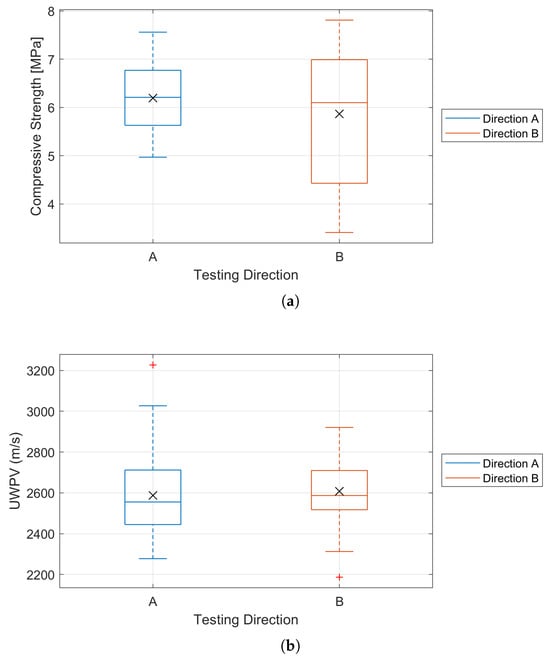
Figure 9.
Box-and-Whisker plot of the results for compressive test (a) and UWPV test (b) for directions A and B. The horizontal line in the box is the median, the cross (x) indicates the mean value. The lines extending from the box (whiskers) indicate the range of the data, and any data points beyond them are considered outliers (marked as ‘+’).
3.2. Dependence on Sample Size
UWPV tests and uniaxial compressive tests were performed to determine whether the size of natural stone specimens has a significant effect on the measured mechanical properties (velocity of propagation and compressive strength).
Based on this, twenty 50 × 50 × 50 mm3 and an equal number of 70 × 70 × 70 mm3 samples were tested (Figure 10).
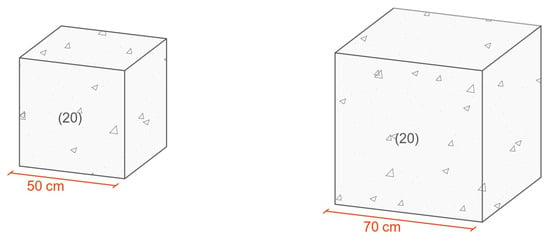
Figure 10.
Cubic samples used for dependence on sample size study.
A t-test for independent samples was conducted, with the null hypothesis () stating that there is no significant difference between the two specimen sizes, and the alternative hypothesis () suggesting that specimen size does influence the measured mechanical properties.
For the UWPV test, the results showed that the t Statistic (t Stat) was , which is lower than the Critical t-Value (t Critical two-tail) of . Additionally, the p-value (two-tailed) was , which is well above the standard significance level of . Similarly, for the compressive test, the results showed a t Statistic (t Stat) of , also lower than the Critical t-Value (t Critical two-tail) of , with a p-value (two-tailed) of .
Since t Stat Critical and in both tests, we fail to reject the null hypothesis () in both cases. These findings indicate that there is no statistically significant difference in compressive strength or UWPV between the two specimen sizes, suggesting that specimen size does not have a measurable effect on the tested properties.
The Box-and-Whisker plots of the results can be consulted in Figure 11.
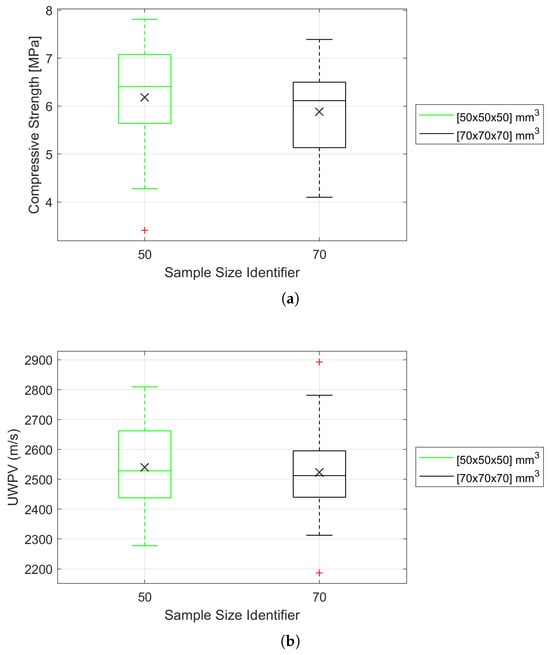
Figure 11.
Box-and-Whisker plot of the results for the compressive test (a) and UWPV test (b) for 50 mm cubic samples and 70 mm cubic samples. The horizontal line in the box is the median, the cross (x) indicates the mean value. The lines extending from the box (whiskers) indicate the range of the data, and any data points beyond them are considered outliers (marked as ‘+’).
3.3. Determination of the Mechanical Properties of the Stone
To establish a robust reference dataset for the intended correlations and to characterise the natural stone under study, the mechanical tests described in Section 2.3.2 were performed. The number of tests and shape of the tested samples can be seen in Table 5 and Figure 12. The samples were obtained from six different ashlars, although only three of them (1, 2, and 3) were tested in bending and tension. Given the absence of anisotropy and size dependence, the results of all the tested samples and loading directions are deemed valid and grouped together.

Table 5.
Number and dimensions of the samples tested for each test type.
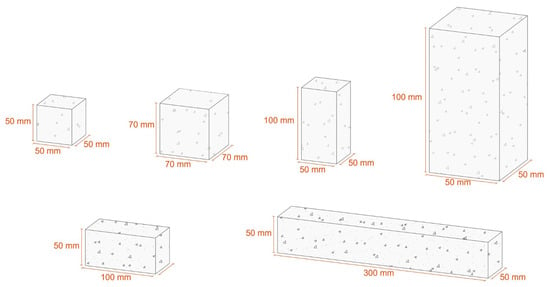
Figure 12.
Samples used for the determination of the mechanical properties of the natural stone and their dimensions.
The results of the tests, clustered by ashlar, can be consulted in Table 6. Two types of samples were used for the uniaxial compression test: cubic (ashlars 1, 2, and 3) and prismatic (ashlars 4, 5, and 6). According to EN 772-1 [], a shape factor of 0.96 was applied to cubic samples and 1.27 to prismatic ones, reflecting a 30% difference.

Table 6.
Average mechanical property values for each ashlar (1 to 6).
3.4. Correlation Between Compressive Strength and UWPV
The relationship between ultrasonic wave propagation velocity (UWPV) and compressive strength () was examined using two datasets: (i) all individual sample measurements and (ii) the ashlar averaged values.
The Pearson correlation coefficient (r) is used to quantify the strength and direction of the correlation. A value of was found for the individual sample set and of for the ashlar values, indicating a linear relationship between UWPV and .
To quantify this relationship further, a linear regression model was fitted to each dataset (Figure 13). For the ashlar averaged values, the regression yields R2 = 0.86, indicating that UWPV explains 84.7% of the variance in compressive strength. The p-value for UWPV () indicates that the relationship is statistically significant. The corresponding linear regression equation is presented in Equation (4).
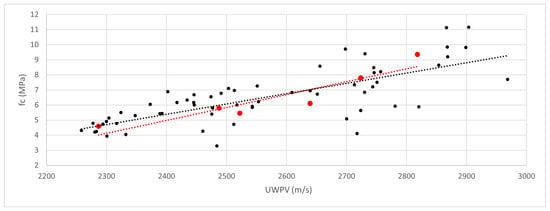
Figure 13.
Correlation between ultrasonic wave propagation velocity (UWPV) and compressive strength (fc) for (i) individual sample measurements (black points) and (ii) ashlar averaged values (red points). Dashed lines indicate the corresponding linear regressions.
When all individual sample values are considered, a very similar linear trend is observed ( = + 0.0068·UWPV) but with greater dispersion, resulting in a lower coefficient of determination (R2 = 0.56). This increased scatter reflects the micro-scale heterogeneity of the biocalcarenite and the specimen-level variability inherent to destructive testing, without altering the underlying physical relationship.
It is worth noting that the aim of this study is to provide a procedure for in situ characterisation of monumental stone using ultrasonic testing. In practical applications, multiple ultrasonic measurements would be taken on a single ashlar (similarly to rebound hammer testing), averaged, and then used to estimate the mechanical strength. Therefore, analysing data at the ashlar level not only reduces micro-scale variability but also mirrors the real conditions and objectives of in situ assessment.
3.5. Correlation Between Compressive Strength and Tensile and Flexural Strength
Finally, this study aims to establish correlations between compressive strength () and other key mechanical properties, specifically tensile strength () and flexural strength (). This will allow such properties to be obtained indirectly from the non-destructive in situ testing.
Again, the strength of these correlations was quantified using the Pearson coefficient (r). A strong positive linear relationship was found between flexural () and compressive strength (), with . In contrast, the correlation between tensile () and compressive strength () was weaker, with , indicating only a moderate relationship.
Based on these results, linear regressions were performed (Figure 14). A strong linear correlation was observed between compressive and flexural strength (), as shown in Equation (5). However, the regression for compressive versus tensile strength resulted in an R2 of , which is not satisfactory (see Figure 14b). These results suggest that while the correlation between compressive and flexural strength is strong, the relationship with tensile strength is less reliable. Further testing may be necessary to refine this correlation.
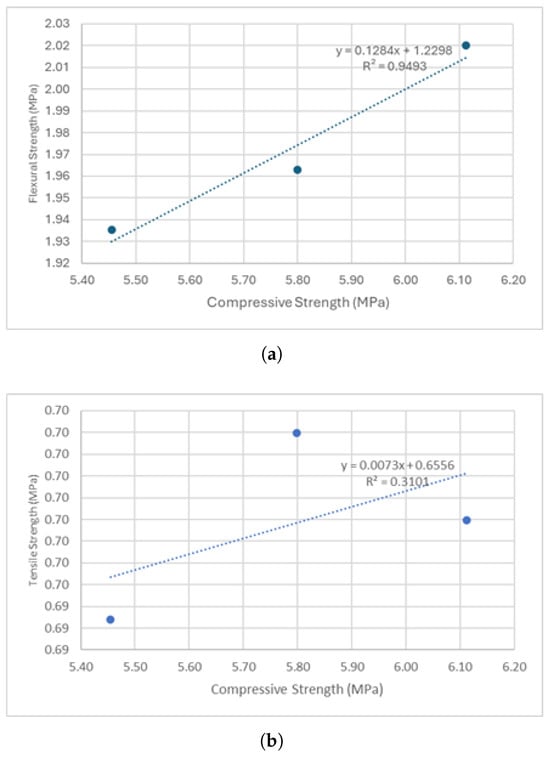
Figure 14.
Correlation between compressive and flexural strength (a) and tensile strength (b).
4. Conclusions
This study aimed to establish reliable correlations for the non-destructive assessment of heritage buildings constructed with Córdoba freestone, a Miocene biocalcarenite widely used in the city’s monuments—including the Great Mosque of Córdoba—and still employed in their restoration. Ultrasonic testing was applied to estimate the mechanical properties of this stone without causing damage, which is of particular importance for UNESCO World Heritage sites, where destructive sampling is not permitted.
To achieve this objective, six ashlars were cut into smaller samples and analysed using ultrasonic tests, measuring ultrasonic wave propagation velocities (UWPVs) through multiple samples and directions. The samples were then mechanically tested to determine compressive, flexural, and tensile strength. Together, these tests provide the first comprehensive mechanical characterisation of Córdoba freestone based on laboratory experiments. The results were subsequently used to establish correlations between UWPV and the main mechanical properties.
The primary objective of validating ultrasonic testing as a viable tool for assessing the mechanical properties of the stone in situ was successfully achieved. The correlations were established at the ashlar scale, which is the most representative level for practical on-site applications and avoids the variability associated with individual small specimens. The results confirmed that UWPV is a strong predictor of compressive strength, with a Pearson correlation coefficient of and a regression coefficient of .
The secondary objectives were also fulfilled. The stone’s anisotropic behaviour was examined, and no significant differences in mechanical response were observed between the two principal directions tested (A and B), indicating isotropic behaviour. In addition, no dependence between sample size and measured mechanical properties was detected, as tests on both 50 × 50 × 50 mm3 and 70 × 70 × 70 mm3 samples yielded consistent results. Mechanical testing of the ashlars provided reliable reference values that supported the subsequent correlation analyses.
This study also identified significant relationships between compressive strength () and other key mechanical properties. A strong linear correlation was observed between flexural and compressive strength (), while the correlation with tensile strength () was weaker and less consistent. These findings support the potential of UWPV as an indicator of multiple mechanical properties, although further testing is required to explore approaches for improving the estimation of tensile strength.
Overall, this research confirms the reliability of the UWPV method as an efficient, non-destructive approach for estimating the mechanical properties of heritage stones. The established correlations provide a practical framework for on-site evaluation, offering a valuable tool for the conservation and maintenance of heritage structures, especially where destructive testing is not feasible, such as in UNESCO sites.
The novelty of this work lies in the systematic validation of the UWPV method for Cordoba freestone, which combines mechanical and ultrasonic tests to develop robust predictive relationships. This represents an innovative step toward the non-destructive evaluation of mechanical properties in built heritage constructed with this material and, more broadly, with other natural soft stones such as biocalcarenites and sandstones commonly used in historical architecture.
Nevertheless, since this study focused on a single stone type with relatively similar properties (compressive strengths ranging from 4.6 to 9.4 MPa), the generalisation of the results is limited. Future research will aim to expand the dataset to include a wider range of ashlars from different quarries and explore the method’s applicability to other stone types.
Further work will also involve validating the methodology in situ, ideally on a building where samples can be extracted and tested in the laboratory. Extending this study to replicated wall structures could also provide valuable insights into the role of mortar and the performance of the method at the masonry scale.
Author Contributions
Conceptualisation, B.Z.-B., J.D.R.-M. and M.S.M.; methodology, B.Z.-B., J.D.R.-M. and M.S.M.; software, B.Z.-B. and J.D.R.-M.; validation, B.Z.-B., J.D.R.-M. and M.S.M.; formal analysis, B.Z.-B., J.D.R.-M. and M.S.M.; investigation, B.Z.-B., J.D.R.-M. and M.S.M.; resources, B.Z.-B.; data curation, B.Z.-B. and J.D.R.-M.; writing—original draft preparation, B.Z.-B., J.D.R.-M. and M.S.M.; writing—review and editing, B.Z.-B., J.D.R.-M. and M.S.M.; visualisation, B.Z.-B., J.D.R.-M. and M.S.M.; supervision, M.S.M.; project administration, B.Z.-B.; funding acquisition, B.Z.-B. and M.S.M. All authors have read and agreed to the published version of the manuscript.
Funding
This research was funded by the Junta de Andalucía, Consejería de Universidad, Investigación e Innovación, Spain, through its EMERGIA program for research talent attraction (EMC21-00255) and the Spanish Ministry of Science and Innovation through the research project PID2022-138674OB-C21.
Data Availability Statement
The data are available at https://idus.us.es/items/2e985d2e-e563-4d7d-bc7b-6ced629edc78 (accessed on 30 October 2025).
Acknowledgments
The authors would like to express their sincere appreciation to Miguel Carrión Colchero, laboratory technician, for his valuable assistance during the experimental campaign and to Pablo Máquez García for his contribution to the graphical design.
Conflicts of Interest
The authors declare no conflicts of interest.
References
- UNESCO World Heritage Centre. Historic Centre of Cordoba. Available online: https://whc.unesco.org/en/list/313 (accessed on 4 September 2025).
- National Geographic. La Mezquita de Córdoba, el Esplendor de Al-Andalus. Available online: https://historia.nationalgeographic.com.es/a/mezquita-cordoba-esplendor-al-andalus_16265 (accessed on 4 September 2025).
- González Gutiérrez, C. Spolia and Umayyad Mosques: Examples and Meanings in Córdoba and Madinat al-Zahra’. J. Islam. Archaeol. 2022, 9, 83–104. [Google Scholar] [CrossRef]
- Barrios Neira, J.; Nieto Cumplido, M.; Palma, J.; Montealegre de Contreras, L. Contribución al estudio litológico de los materiales empleados en monumentos de Córdoba de distintas épocas. In Arqueología de la Arquitectura; CSIC: Madrid, Spain, 2003; pp. 47–84. [Google Scholar] [CrossRef]
- Spathis, P.; Mavrommati, M.; Gkrava, E.; Tsiridis, V.; Evgenidis, S.; Karapanagiotis, I.; Melfos, V.; Karapantsios, T. Characterization of Natural Stone from the Archaeological Site of Pella, Macedonia, Northern Greece. Heritage 2021, 4, 4665–4677. [Google Scholar] [CrossRef]
- Salvatici, T.; Calandra, S.; Centauro, I.; Pecchioni, E.; Intrieri, E.; Garzonio, C. Monitoring and Evaluation of Sandstone Decay Adopting Non-Destructive Techniques: On-Site Application on Building Stones. Heritage 2020, 3, 1287–1301. [Google Scholar] [CrossRef]
- Grazzini, A.; Fasana, S.; Zerbinatti, M.; Lacidogna, G. Non-Destructive Tests for Damage Evaluation of Stone Columns: The Case Study of Sacro Monte in Ghiffa (Italy). Appl. Sci. 2020, 10, 2673. [Google Scholar] [CrossRef]
- Napolitano, R.; Hess, M.; Glisic, B. Integrating Non-Destructive Testing, Laser Scanning, and Numerical Modeling for Damage Assessment: The Room of the Elements. Heritage 2019, 2, 151–168. [Google Scholar] [CrossRef]
- Gonen, S.; Pulatsu, B.; Erdogmus, E.; Karaesmen, E.; Karaesmen, E. Quasi-Static Nonlinear Seismic Assessment of a Fourth Century A.D. Roman Aqueduct in Istanbul, Turkey. Heritage 2021, 4, 401–421. [Google Scholar] [CrossRef]
- Tejedor, B.; Lucchi, E.; Bienvenido-Huertas, D.; Nardi, I. Non-destructive techniques (NDT) for the diagnosis of heritage buildings: Traditional procedures and futures perspectives. Energy Build. 2022, 263, 112029. [Google Scholar] [CrossRef]
- Matias, M.; Almeida, F.; Moura, R.; Barraca, N. High resolution NDT in the characterization of the inner structure and materials of heritage buildings walls and columns. Constr. Build. Mater. 2021, 267, 121726. [Google Scholar] [CrossRef]
- Patil, S.; Kasthurba, A.; Patil, M. Evaluation of heritage stone deterioration through non-destructive techniques (ultrasonic pulse velocity, rebound hammer test, SEM, and X-ray diffraction). In Diagnosis of Heritage Buildings by Non-Destructive Techniques; Elsevier: Amsterdam, The Netherlands, 2024; pp. 529–550. [Google Scholar] [CrossRef]
- Martini, R.; Carvalho, J.; Mesquita, E.; Arêde, A.; Varum, H. Sonic test singularities of granite stone masonries. Constr. Build. Mater. 2023, 397, 132391. [Google Scholar] [CrossRef]
- Foorginejad, A.; Taheri, M.; Mollayi, N. A Non-destructive Ultrasonic Testing Approach for Measurement and Modelling of Tensile Strength in Rubbers. Int. J. Eng. Trans. C Asp. 2020, 33, 2549–2555. [Google Scholar]
- Pozhanka, M.; Zagrai, A.; Baez Avila, F.; Drach, B. Application of Ultrasonic Testing for Assessing the Elastic Properties of PLA Manufactured by Fused Deposition Modeling. Appl. Sci. 2024, 14, 7639. [Google Scholar] [CrossRef]
- Martini, R.; Carvalho, J.; Arêde, A.; Varum, H. Correlation Between Sonic and Mechanical Test Results on Stone Masonry Walls. In Structural Analysis of Historical Constructions; Aguilar, R., Torrealva, D., Moreira, S., Pando, M.A., Ramos, L.F., Eds.; Springer International Publishing: Cham, Switzerland, 2019; pp. 456–464. [Google Scholar] [CrossRef]
- Łukomski, T.; Stepinski, T. Steel hardness evaluation based on ultrasound velocity measurements. Insight Non-Destr. Test. Cond. Monit. 2010, 52, 592–596. [Google Scholar] [CrossRef]
- Mikulic, D.; Sekulic, D.; Štirmer, N.; Bjegovic, D. Application of ultrasonic methods for early age concrete characterisation. In Proceedings of the 8th International Conference of the Slovenian Society for Non-Destructive Testing: Application of Contemporary Non-Destructive Testing in Engineering, Portoroz, Slovenia, 1–3 September 2005; pp. 99–108. [Google Scholar]
- Amjad, U.; Saadeh, M.; Raqeeb, A.M.; Bader, N.; Alnuaimi, H.; Irshida, M.R. Characterization and evaluation of mortar composites using linear and nonlinear ultrasonic techniques. In Proceedings of the 2024 51st Annual Review of Progress in Quantitative Nondestructive Evaluation, QNDE 2024, Denver, CO, USA, 21–24 July 2024. [Google Scholar] [CrossRef]
- Sánchez, J.A.; Spalvier, A.; Pérez, N. Ultrasonic Characterization of Pervious Concrete. In Proceedings of the 2023 15th IEEE International Conference on Industry Applications, INDUSCON 2023—Proceedings, São Bernardo do Campo, Brazil, 22–24 November 2023; pp. 1284–1288. [Google Scholar] [CrossRef]
- Benavente, D.; Fort, R.; Gomez-Heras, M. Improving uniaxial compressive strength estimation of carbonate sedimentary rocks by combining minimally invasive and non-destructive techniques. Int. J. Rock Mech. Min. Sci. 2021, 147, 104915. [Google Scholar] [CrossRef]
- Bourgeois, I.; Gregorio, L.; Rodrigues, H.; Fonseca, J.; Tavares, A.; Costa, A. Application of Sonic Tests and Modal Identification in the Characterization of Masonry Walls. Appl. Sci. 2023, 13, 3762. [Google Scholar] [CrossRef]
- Ortega, J.; Stepinac, M.; Lulić, L.; Núñez García, M.; Saloustros, S.; Aranha, C.; Greco, F. Correlation between sonic pulse velocity and flat-jack tests for the estimation of the elastic properties of unreinforced brick masonry: Case studies from Croatia. Case Stud. Constr. Mater. 2023, 19, e02467. [Google Scholar] [CrossRef]
- Ortega, J.; Meersman, M.F.; Aparicio, S.; Liébana, J.C.; Anaya, J.J.; González, M. Influence of stress level and damage on sonic tomography imaging and on the estimation of deformability properties of historic stone masonry. Constr. Build. Mater. 2024, 417, 135285. [Google Scholar] [CrossRef]
- Montealegre, L.; Barrios, J.; Nieto, M. The Materials of Construction of the West Wall of the Mosque of Córdoba (Spain) and Their Deterioration. In Proceedings of the 3rd International Symposium on the Conservation of Monuments in the Mediterranean Basin, Venice, Italy, 22–25 June 1994; pp. 51–57. [Google Scholar]
- Barrios Neira, J.; Montealegre, L.; Ortega, A.; Meroño, J.E.; Aguilera, M.L. Biocalcarenites as construction materials in Santa Marina de Aguas Santas Church at Cordoba, Spain. Mater. Construc. 2009, 59, 125–134. [Google Scholar] [CrossRef]
- Mármoles y Piedras Gutierrez. Available online: http://mypg.es/index2.html (accessed on 4 September 2025).
- UNE-EN 1936:2007; Natural Stone Test Methods—Determination of Real Density and Apparent Density, and of Total and Open Porosity. Asociación Española de Normalización (AENOR): Madrid, Spain, 2007.
- Huesca-Tortosa, M.; Navarro-Jiménez, M.; Rodríguez-García, J. Evaluation of Eco-Friendly Consolidating Treatments in Pugliese Tuff (Gravina Calcarenite). Buildings 2024, 14, 940. [Google Scholar] [CrossRef]
- UNE-EN 14579:2005; Natural Stone Test Methods—Determination of Sound Speed Propagation. Asociación Española de Normalización(AENOR): Madrid, Spain, 2005.
- UNE-EN 1926:2007; Natural Stone Test Methods—Determination of Uniaxial Compressive Strength. Asociación Española de Normalización (AENOR): Madrid, Spain, 2007.
- UNE-EN 12372:2022; Natural Stone Test Methods—Determination of Flexural Strength Under Concentrated Load. Asociación Española de Normalización (AENOR): Madrid, Spain, 2022.
- UNE 22950-2:1990; Mechanical Properties of Rocks. Strength Determination Tests. Part 2: Tensile Strength. Indirect Determination (Brazilian Test). Asociación Española de Normalización (AENOR): Madrid, Spain, 1990.
- UNE-EN 12390-6:2024; Testing Hardened Concrete—Part 6: Tensile Splitting Strength of Test Specimens. Asociación Española de Normalización (AENOR): Madrid, Spain, 2024.
- EN 772-1:2011+A1:2015; Methods of Test for Masonry Units—Part 1: Determination of Compressive Strength. CEN: Brussels, Belgium, 2015.
Disclaimer/Publisher’s Note: The statements, opinions and data contained in all publications are solely those of the individual author(s) and contributor(s) and not of MDPI and/or the editor(s). MDPI and/or the editor(s) disclaim responsibility for any injury to people or property resulting from any ideas, methods, instructions or products referred to in the content. |
© 2025 by the authors. Licensee MDPI, Basel, Switzerland. This article is an open access article distributed under the terms and conditions of the Creative Commons Attribution (CC BY) license (https://creativecommons.org/licenses/by/4.0/).